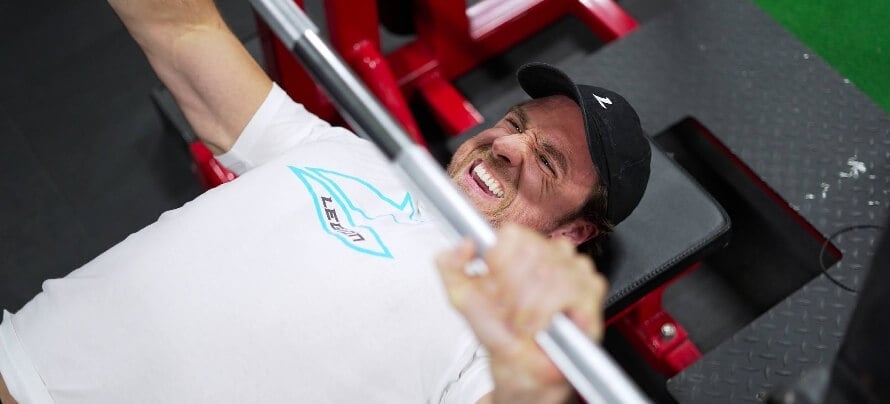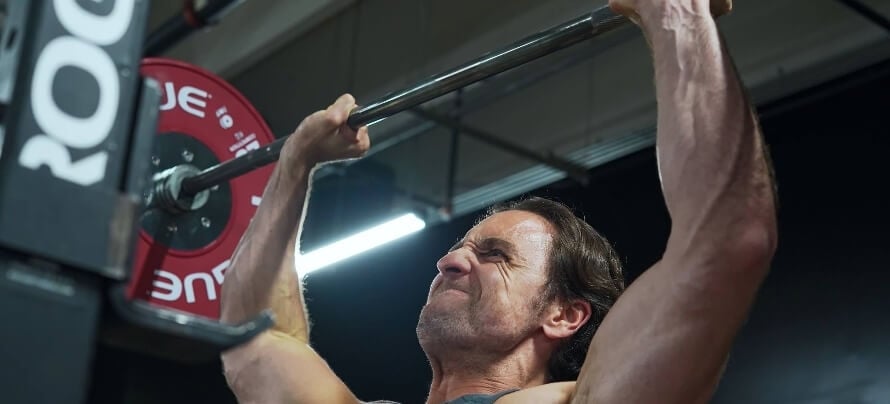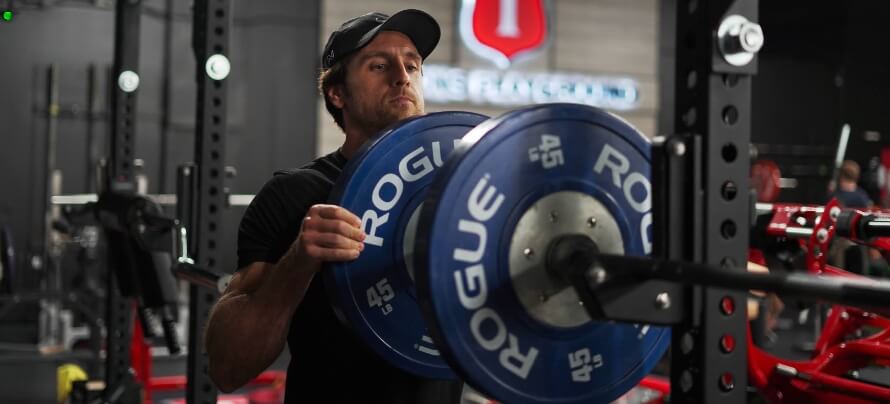You might have heard weightlifters speaking about hitting a brand new “PR”, however what does a PR imply within the fitness center?
And why do individuals recommend hitting PRs is the gold customary of progress?
PR stands for “private report,” and it represents your best-ever efficiency in a particular train.
There are a number of sorts of PRs within the fitness center, too, and every gives a special strategy to observe your beneficial properties. However the widespread thread is that this: in case your PRs are going up over time, you’re getting stronger, larger, quicker, or fitter.
On this article, you’ll study all of the sorts of fitness center PRs, why monitoring them advantages progress, methods to set and break a PR, and extra.
Key Takeaways
- Within the fitness center, a “PR” or “private report” represents your greatest efficiency in a particular train, whether or not it’s your heaviest elevate, most reps, or longest run.
- You possibly can set a number of sorts of PRs—weight, rep, RPE, and quantity PRs—all of which enable you to gauge enhancements in energy.
- Since energy achieve is a proxy for muscle development, monitoring PRs helps you perceive for those who’re constructing muscle.
- Monitoring PRs additionally highlights your weak spot, which helps you establish areas it is advisable enhance.
- You possibly can enhance your efficiency throughout a PR try utilizing the methods mentioned on this article.
What Does “PR” Imply within the Health club?


Within the fitness center, “PR” stands for “private report.” Individuals additionally typically check with a PR as a “PB,” or “private greatest.”
It’s a time period used to explain your greatest efficiency in a particular train—typically the heaviest weight lifted for a single rep or essentially the most reps accomplished at a sure weight.
As an illustration, in case your greatest deadlift was 300 kilos and also you pull 305, that’s a brand new PR. Or for those who’ve benched 225 kilos for 5 reps and later handle six, that’s one other PR.
Most individuals affiliate PRs in weightlifting with compound workouts just like the squat, bench press, and deadlift, however you’ll be able to set a PR in any train, even cardio.
For instance, you may set a PR in your quickest 5-mile run, longest bike experience, and even essentially the most consecutive days you’ve gone for a stroll.
Varieties of PR within the Health club
In weightlifting, there are a number of sorts of PRs you’ll be able to purpose for:
- Weight PR: Your heaviest elevate for a particular train. For instance, for those who squat 350 kilos for the primary time, that’s a brand new weight PR. If you elevate the utmost weight you’ll be able to deal with for a single rep, it’s additionally thought-about a one-rep max (1RM). Nonetheless, weight PRs don’t at all times should be 1RMs—they may also be your greatest elevate for a number of reps, like a 3-rep max, for instance.
- Rep PR: Essentially the most reps you’ll be able to full at a sure weight. In case you handle 8 reps at 225 kilos on the bench press when your earlier greatest was seven, you’ve set a brand new rep PR.
- RPE PR: Your greatest elevate primarily based on price of perceived exertion (RPE), which measures how laborious a set feels. In case you deadlift 300 kilos with an RPE of seven when it used to really feel like a 9, that’s an RPE PR.
- Quantity PR: Your highest whole work achieved on a single train in a exercise. As an illustration, for those who do 12 whole reps throughout 3 units of squats one week, then full 13 whole reps throughout 3 units the next week with the identical weight, you’ve set a brand new quantity PR.
Whereas weight PRs are inclined to get essentially the most consideration amongst weightlifters, every kind of PR gives helpful insights into how your energy and endurance are progressing.
Advantages of Monitoring Private Data (PRs) within the Health club


The primary advantage of monitoring PRs (weight, rep, RPE, and quantity) is that it’s one of the dependable methods to measure your progress—in the event that they’re growing over time, you’re gaining energy.
And that’s necessary as a result of gaining energy is a wonderful indication you’re gaining muscle.
Monitoring your PRs additionally helps you make sure you’re coaching with sufficient depth to maximise beneficial properties.
In relation to hypertrophy, the candy spot for coaching depth is about 1-to-3 reps shy of failure (the purpose at which you’ll be able to’t full one other rep with good kind). Coaching nearer to failure (0-to-1 reps shy) can intervene with restoration and long-term progress, whereas coaching farther from failure (4+ reps shy) isn’t sufficient to maximise muscle achieve.
Setting your coaching weights primarily based in your PRs is likely one of the greatest methods to hit this “Goldilocks zone” of depth. For instance, if you already know your all-out deadlift PR is 300 kilos for 4 reps, you may purpose for round 280 kilos for 3 units of 4-to-6 reps to make sure you’re coaching laborious with out overdoing it.
One other advantage of monitoring PRs is that it retains your exercises purposeful. Every PR tells you the place you’re making strides and the place you’re weakest, which helps you perceive what it is advisable deal with.
In brief, monitoring PRs makes progress measurable and exercises significant—two necessities for long-term consistency and success within the fitness center.
Learn how to Set and Break a PR
Setting common PRs begins with following a well-designed energy coaching program.
Supplied your routine focuses on progressive overload—the systematic technique of lifting progressively heavier weights over time—you’ll don’t have any points setting rep, RPE, and quantity PRs.
Setting a weight PR or one-rep max requires extra technique, although.
Right here’s a step-by-step information on methods to do it. To maintain issues easy, let’s use setting a brand new squat PR for example.
1. Estimate Your One-Rep Max
Begin by calculating your estimated one-rep max for the squat utilizing the calculator beneath.
For an correct estimate, enter essentially the most weight you’ve not too long ago squatted for six reps or fewer.
The Greatest One-Rep Max Calculator for Any Train
As an illustration, for those who not too long ago squatted 200 kilos for five reps, the calculator will estimate your squat one-rep max at round 225 kilos.
2. Prioritize the Train
Transfer the squat to the very begin of your subsequent exercise. As an illustration, if it’s normally the second or third train in your routine, shift it to first. This fashion, you’ll be contemporary and capable of elevate the utmost quantity of weight.
3. Heat Up Accurately
If you arrive on the fitness center in your squat PR exercise, do an intensive warm-up. In accordance to analysis, warming up with heavy weights is one of the simplest ways to prime your physique for heavy weightlifting.
Right here’s the protocol I like to recommend:
- Do 6 reps with about 50% of your estimated one-rep max (110 kilos), then relaxation for a minute.
- Do 4 reps with about 70% of your estimated one-rep max (155 kilos), then relaxation for a minute.
- Do 1 rep with about 90% of your estimated one-rep max (200 kilos), then relaxation for 3-to-5 minutes.
This strategy primes your muscle tissue in your PR try with out fatiguing you, so that you’re able to elevate at your greatest.
4. Try Your Estimated One-Rep Max
In case your final warm-up set felt easy, load the bar together with your estimated one-rep max (225 kilos, on this instance). Set the spotter arms on the squat rack at an applicable top or recruit a spotter, then carry out no matter psychological or bodily rituals you employ to get hyped for a heavy elevate (extra on these quickly).
Assuming you accomplished the PR rep, you’ll be able to proceed in considered one of two methods:
- If the rep felt easy and managed, you’re probably able to push for extra weight, so transfer on to the following step.
- If it felt robust or for those who needed to grind by the rep, contemplate this your max for the day and name it there.
And for those who fail the rep, it’s normally greatest to not retry that day. A number of makes an attempt at a one-rep max are exhausting and should intervene with restoration and upcoming exercises, so it’s normally smarter to attempt once more one other time.
5. Improve the Weight in Small Increments
If 225 kilos felt manageable, add 3-to-5% extra weight (as much as roughly 230-to-235 kilos on this instance) and try one other rep.
Repeat this course of, including weight in related increments and resting for five minutes between makes an attempt, till you attain a degree the place you’re feeling one other enhance isn’t possible.
The very best weight you had been capable of squat for a single rep is your new one-rep max PR.
6. Repeat the Total Course of Each 6-to-12 Months
Testing your one-rep max too regularly can intervene together with your coaching and restoration, so purpose to repeat this course of each 6-to-12 months.
This cadence offers your physique the time it must adapt and get stronger with out ready so lengthy that progress turns into laborious to trace.
In different phrases, it’s the optimum frequency to make sure you’re at all times prepared to interrupt your earlier PR.
5 Ideas for Enhancing your PRs on the Health club


1. Pump Your self Up
Analysis exhibits that psyching your self up earlier than a heavy set can considerably impression the quantity of weight you’ll be able to elevate.
Merely take 10-to-15 seconds earlier than your set to give attention to the train you’re about to carry out and visualize your self performing it efficiently.
Listening to motivational music, doing respiratory workouts, and mentally reciting cues also can work.
2. Elevate Explosively
Research present that lifting explosively is superior to lifting slowly when coaching with heavy weights.
That doesn’t imply you must elevate explosively on the expense of excellent kind; moderately you must elevate weights as quick as attainable whereas utilizing correct method and controlling the load.
To be taught extra about lifting tempo, take a look at this text:
Ought to You Elevate Weights Quick or Gradual? The Fast and Soiled Information
3. Keep Off Your Cellphone Between Makes an attempt
Analysis suggests that durdling in your cellphone between units can lower your energy by inflicting “psychological fatigue”—a psychobiological state characterised by emotions of tiredness you normally expertise after demanding cognitive duties.
What’s extra, sustaining focus between units, by avoiding distractions like your cellphone, can sharpen your psychological state and increase your efficiency.
4. Grip the Bar as Arduous as Potential
For a simple energy increase, grip the barbell as laborious as you’ll be able to, clench your jaw muscle tissue, and push your tongue into the roof of your mouth. A number of research present that doing so boosts your energy and energy manufacturing.
To be taught extra about this phenomenon, take a look at this text:
Learn how to Use Distant Voluntary Contraction to Immediately Get Stronger
5. Take the Proper Dietary supplements
These dietary supplements will enable you to set common PRs on the fitness center:
- Protein powder: Protein powder, resembling whey or casein, gives your physique with the vitamins wanted to construct muscle tissue and recuperate from exercises.
- Creatine: Creatine dietary supplements, resembling creatine monohydrate powder and gummies, increase muscle and energy achieve, enhance anaerobic endurance, and cut back muscle injury and soreness out of your exercises.
- Pre-workout: A high-quality pre-workout enhances vitality, temper, and focus, will increase energy and endurance, and reduces fatigue.
(In case you’d like much more particular recommendation about which dietary supplements you must take to achieve your well being and health targets, take the Legion Complement Finder Quiz, and in lower than a minute, you’ll know precisely what dietary supplements are best for you.)
Scientific References +
- Er, Helms, et al. “Suggestions for Pure Bodybuilding Contest Preparation: Resistance and Cardiovascular Coaching.” The Journal of Sports activities Medication and Bodily Health, 1 Mar. 2015, pubmed.ncbi.nlm.nih.gov/24998610/.
- Lacerda, Lucas T, et al. “Is Performing Repetitions to Failure Much less Essential than Quantity for Muscle Hypertrophy and Energy?” Journal of Energy and Conditioning Analysis, 2019, p. 10.1519/JSC.0000000000003438, www.ncbi.nlm.nih.gov/pubmed/31809457, https://doi.org/10.1519/JSC.0000000000003438.
- Viveiros, Leonardo, et al. “Excessive-Load and Low-Quantity Heat-up Will increase Efficiency in a Resistance Coaching Session.” Journal of Bodywork and Motion Therapies, vol. 40, 1 Oct. 2024, pp. 1487–1491, https://doi.org/10.1016/j.jbmt.2024.08.004. Accessed 8 Sept. 2024.
- Ribeiro, Bruno, et al. “The Function of Particular Heat-up throughout Bench Press and Squat Workout routines: A Novel Method.” Worldwide Journal of Environmental Analysis and Public Well being, vol. 17, no. 18, 22 Sept. 2020, p. 6882, https://doi.org/10.3390/ijerph17186882. Accessed 25 Mar. 2021.
- Argus, Christos Ok, et al. “Acute Results of Verbal Suggestions on Higher-Physique Efficiency in Elite Athletes.” Journal of Energy and Conditioning Analysis, vol. 25, no. 12, Dec. 2011, pp. 3282–3287, https://doi.org/10.1519/jsc.0b013e3182133b8c.
- Richter, Jeremy, et al. “Maximizing Energy Coaching Efficiency Utilizing Psychological Imagery.” Energy and Conditioning Journal, vol. 34, no. 5, Oct. 2012, pp. 65–69, https://doi.org/10.1519/ssc.0b013e3182668c3d.
- Munn, Joanne, et al. “Resistance Coaching for Energy: Impact of Variety of Units and Contraction Pace.” Medication & Science in Sports activities & Train, vol. 37, no. 9, 1 Sept. 2005, pp. 1622–1626, journals.lww.com/acsm-msse/Fulltext/2005/09000/Resistance_Training_for_Strength__Effect_of_Number.24.aspx, https://doi.org/10.1249/01.mss.0000177583.41245.f8.
- González-Badillo, Juan José, et al. “Maximal Meant Velocity Coaching Induces Larger Features in Bench Press Efficiency than Intentionally Slower Half-Velocity Coaching.” European Journal of Sport Science, vol. 14, no. 8, 15 Apr. 2014, pp. 772–781, https://doi.org/10.1080/17461391.2014.905987.
- Gantois, Petrus, et al. “Psychological Fatigue from Smartphone Use Reduces Quantity-Load in Resistance Coaching: A Randomized, Single-Blinded Cross-over Research.” Perceptual and Motor Abilities, vol. 128, no. 4, 17 Might 2021, pp. 1640–1659, https://doi.org/10.1177/00315125211016233.
- Alix-Fages, Carlos, et al. “Results of Psychological Fatigue on Energy Endurance: A Systematic Evaluate and Meta-Evaluation.” Motor Management, vol. 27, no. 2, 2022, pp. 1–20, https://doi.org/10.1123/mc.2022-0051.
- EBBEN, WILLIAM P., et al. “The Impact of Distant Voluntary Contractions on Knee Extensor Torque.” Medication & Science in Sports activities & Train, vol. 40, no. 10, Oct. 2008, pp. 1805–1809, https://doi.org/10.1249/mss.0b013e31817dc4ad.
- Garceau, Luke R, et al. “Impact of Distant Voluntary Contractions on Higher Physique Pressure and Muscle Activation in Girls and Males.” Journal of Energy and Conditioning Analysis, vol. 24, Jan. 2010, p. 1, https://doi.org/10.1097/01.jsc.0000367113.51402.34.
- Garceau, Luke , et al. “Impact of Distant Voluntary Contractions on Isometric Prime Mover Torque and Electromyography.” ResearchGate, 2024, www.researchgate.web/publication/282724663_Effect_of_remote_voluntary_contractions_on_isometric_prime_mover_torque_and_electromyography.
- Stokes, Tanner, et al. “Current Views Relating to the Function of Dietary Protein for the Promotion of Muscle Hypertrophy with Resistance Train Coaching.” Vitamins, vol. 10, no. 2, 7 Feb. 2018, p. 180, www.mdpi.com/2072-6643/10/2/180/pdf.










Discussion about this post